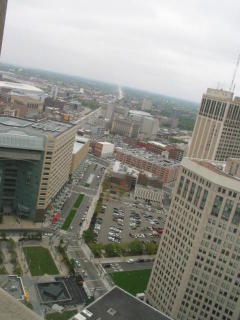
As a Detroit resident, it's impossible to visit anyone in the suburbs without getting into a conversation about the city and having to answer questions about its overall health and future. It's as if I have to be an expert on the city, know everything about its politics, night life, neighborhoods and people. When I'm in these conversations with my suburban friends, I sometimes feel like a spy who slips in and out of Detroit to gather intelligence and report back to them on life in the troubled, dangerous city.
Most of these folks rarely come to the city, and when they do it's for a concert or a game, maybe a quick drink, then they hit the freeway for the run back home. Their beliefs about the city are formed by these occasional trips plus what they read in the newspapers and see on television. I believe that they truly want the city to succeed and wish it well, but they have no sense of ownership in its future.
When I find myself in these conversations I always feel conflicted about what to say. On one hand I see the city like so many do -- bleak and a lost cause. And on the other I see a city of promise and optimism. To paraphrase Detroit News columnist Betty DeRamus who paraphrases author Charles Dickens, I see Detroit as existing in the "best of times and the worst of times." Therein lies my conflict. Am I supposed to be a PR person for the city and talk about its promising economic development, new housing, newly-paved streets and new restaurants? Or do I give them a vicarious thrill and talk about the gunshots at night, the wall-to-wall blight, the three out four families without live-at-home fathers, and a 14 percent unemployment rate?
There was a time when I would say that I could walk through any Detroit neighborhood at two a.m. without fear of being harmed in any way. I would say this not to suggest that I was some daring, streetwise (white) guy, but to make the point that Detroit was really a safe city. But I don't think I can say that anymore. Neighborhoods that were once borderline ghetto have deteriorated significantly in the pasts five years into barely livable war zones.
Several weeks ago I drove through the city's near northeast side, near Dequinder and Six Mile. It was scary, and it was sad. The area is filled with side streets that are pockmarked with burned-out bungalows and unkempt empty lots. Young men hung out on street corners, in front of beer stores and on front porches, and they stared at me as I rode by, wondering perhaps whether I was a cop, landlord, or just another guy slumming.
Detroit's financial crisis is daunting. Recently its independent auditor Joe Harris said the city will go broke if dramatic cuts in employees and employee benefits are not made soon. He says the city's deficit will hit $336 million by June 2006 if nothing is done. The mayor claims the deficit is $79 million. Whatever the amount, the deficit is exacerbated by the steady flow of middle class families leaving the city.
According to the U.S. Census Bureau, nearly 200 persons leave the city every week. Since the city is 85 percent African-American, the white flight of previous decades has become black flight. The people leaving are middle and upper class taxpayers who are taking their city tax dollars and disposable income with them. The sad irony in this is that back in the day we fought and won the battle for equal housing. One unintended consequence of this victory is that now affluent blacks are leaving the city for the good schools and safety of the suburbs.
And there's the other Detroit. The Super Bowl's coming in January 2006 and and the city's host committee is doing a wonderful job preparing for it. I have lived downtown or near it for most of my life and it hasn't looked this good in 35 years. Every downtown street is freshly paved. A new Campius Marcius park with a skating rink, bandshell, French coffee shop and traffic circle have replaced old and drab Kennedy Square. The new Compuware skyscraper with a Hard Rock Cafe, Border's bookstore and other retail has brought hundreds of new employees and street life to the area.
Old buildings converted into pricey new lofts are now everywhere downtown. Harmonie Park with the toney Rhino restaurant is the new hot spot for the young and the restless (as well as the not-so-young and rested). Up the street, the Lions and Tigers play to capacity crowds in new world-class venues and the Detroit Athletic Club thrives as one of the finest and most prestigious private clubs in the nation.
Thanks to GM and others, our beautiful riverfront has finally been discovered and a five-mile riverwalk from the Ambassador Bridge to Belle Isle is taking shape. Soon a string of parks, a marina, Chene Park, a walking and jogging path, restaurants, condos, nightclubs and retail shops will stretch from bridge to bridge. (Mayor Coleman Young had this idea in the eighties but couldn't get the support to build it.) And all this is added to a dramatically improved and now user-friendly Renaissance Center.
So what do I tell my suburban friends when they ask how things are going in Detroit? I tell them the truth.
(Photo by Corbett Kid from his office in the Penobscot Building, downtown Detroit, looking northeast. The small ribbon running into the horizon is Gratiot Avenue.)
